Grace Elliot's Blog: 'Familiar Felines.' , page 27
October 2, 2011
Rules Not to be Broken.
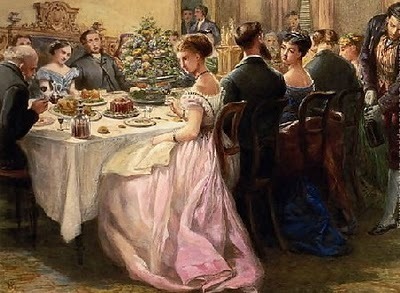
It's tempting to think that the 19th century was governed by rules. Even a simple thing such as moving around the house in company, had rules attached:
"The lady should be given the wall when descending stairs, but if merely passing from room to room, the man's right arm should be offered to her."
But rules abounded nowhere quite so much as hosting a dinner party.
"The direction of a table is no inconsiderate branch of a lady's concern."
There were strict orders of precedence to be obeyed, with the highest ranked in society commanding the most prestigious place at table. The lady of the house sat at the head of the table, with the gentleman of highest rank on her right, and the gentlemen next in rank to her left. This arrangement was mirrored at the bottom of the table for the gentleman of the house.
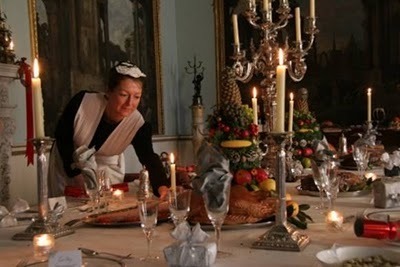
But the finer rules of etiquette were constantly changing.
"…what is considered the height of good taste one year, is declared vulgar the next."
What a nightmare for the aspiring hostess!
"If a lady…be invited to take wine…they must never refuse; it is very gauche to do so. They need not drink half a glass, but merely taste of it."
And at the dinner table,
"Ladies are not to dine with their gloves on, unless their hands are not fit to be seen."
However servants were to wait at table wearing clean white gloves because:
"There are few things more disagreeable than the thumb of a clumsy waiter in your plate."
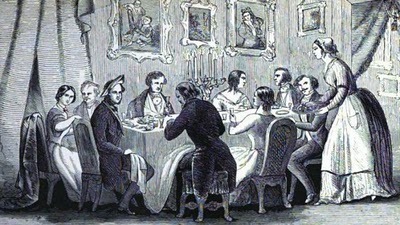
It is hoped some rules never went out of fashion, such as:
"Never use yor knife to convey food to your mouth, under any circumstances. It is unnecessary and glaringly vulgar."
"Making a noise in chewing or breathing hard in eating, are both unseemly habits, and ought to be eschewed."
"Do not pick your teeth much at table as, however satisfactory a practice to yourself, to witness it is not a pleasant thing."
And finally, perhaps a piece of reverse snobbery in this piece of advice about family meals.
"At family dinners, where the common household bread is used, it should never be cut less than an inch and half thick. There is nothing more plebeian that thin bread at dinner."
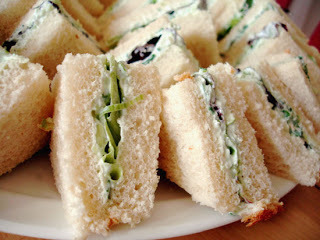
Thin sliced bread, plebeian indeed! Whatever next? Cucumber sandwiches with the crusts on? Heaven forbid!
Published on October 02, 2011 12:29
September 28, 2011
When the Past Becomes History.
'Smuggling, though a real offence, is owing to the laws themselves, for the higher the duties, the greater the advantage and consequently the temptation.'1768 Treatise on Crimes and Punishment, Beccaria.
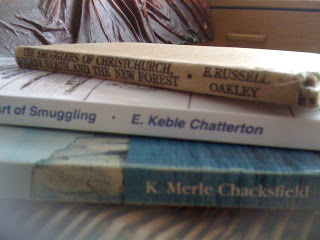 I'm currently researching my WIP (work in progress) about smuggling along the south coast of England in the 18th century, and so imagine my surprise when my husband produced a small beige-coloured book on the subject from our very own bookshelves! The interesting thing is, the more I read, the more I realised this book itself, was a piece of history! 'The Smugglers of Christchurch, Bourne Heath and the New Forest', by E Russell Oakley, published in 1924, turned out to be a wonderful glimpse into the history – not just of smuggling, but also of the 1920's.
I'm currently researching my WIP (work in progress) about smuggling along the south coast of England in the 18th century, and so imagine my surprise when my husband produced a small beige-coloured book on the subject from our very own bookshelves! The interesting thing is, the more I read, the more I realised this book itself, was a piece of history! 'The Smugglers of Christchurch, Bourne Heath and the New Forest', by E Russell Oakley, published in 1924, turned out to be a wonderful glimpse into the history – not just of smuggling, but also of the 1920's.
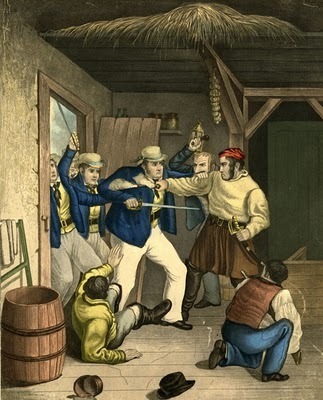 Excisemen tackle some smugglers in their lair.In the book Mr Oakley writes about a talk on smuggling he gave on BBC radio, in January 1924. He recounts the true story of a fast sailing boat with a cargo of contraband tea which, in 1748, was chased by Revenue cutters. In danger of being overhauled and captured, the smugglers jumped overboard in shallow water just off Bourne Heath and swam ashore to escape. In his radio broadcast Mr Oakley bemoans:"It is curious that contemporary records give us so much detail, yet the name of the boat and her home port are not stated."
Excisemen tackle some smugglers in their lair.In the book Mr Oakley writes about a talk on smuggling he gave on BBC radio, in January 1924. He recounts the true story of a fast sailing boat with a cargo of contraband tea which, in 1748, was chased by Revenue cutters. In danger of being overhauled and captured, the smugglers jumped overboard in shallow water just off Bourne Heath and swam ashore to escape. In his radio broadcast Mr Oakley bemoans:"It is curious that contemporary records give us so much detail, yet the name of the boat and her home port are not stated."
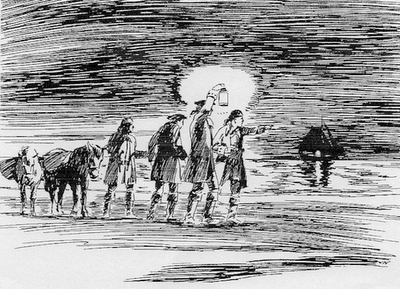 Smugglers ashore, signalling they are ready to recieve the landed contraband.And it's this next bit that I love as a reflection of history-within-history. In his book, Mr Oakley recounts that a week after the program he received a letter which read:"Last week I purchased a wireless set. [Don't you just love it? Owning a radio was so unusual the writer mentioned it in his letter!] Last Saturday night I listened in for the first time and you were the first speaker I have heard on the air."The letter goes onto say:"I am going to tell you something you don't know. That boat belonged to a relative of our family and the loss of it broke his heart and he died soon afterwards. The name of the boat was 'Charles' and she was…an oyster dredger and fishing boat."
Smugglers ashore, signalling they are ready to recieve the landed contraband.And it's this next bit that I love as a reflection of history-within-history. In his book, Mr Oakley recounts that a week after the program he received a letter which read:"Last week I purchased a wireless set. [Don't you just love it? Owning a radio was so unusual the writer mentioned it in his letter!] Last Saturday night I listened in for the first time and you were the first speaker I have heard on the air."The letter goes onto say:"I am going to tell you something you don't know. That boat belonged to a relative of our family and the loss of it broke his heart and he died soon afterwards. The name of the boat was 'Charles' and she was…an oyster dredger and fishing boat."
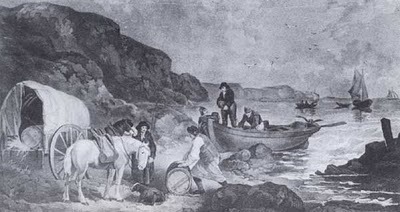 How wonderful, that the new-technology of the 'wireless set' provided an answer to a question nearly two centuries old!
How wonderful, that the new-technology of the 'wireless set' provided an answer to a question nearly two centuries old!
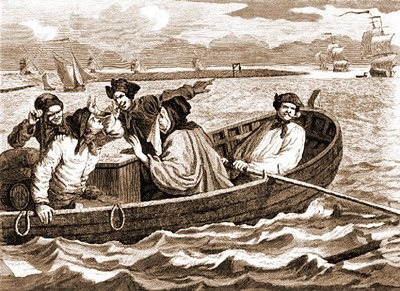 Smugglers at work. Another fascinating glimpse into the past is the mention of what were then hamlets and villages, - Shirley – a hamlet four miles away (now a waste concrete and brick, sprawling suburb of Southampton, and anything less idyllic or hamlet-like it's difficult to imagine.) And of course there is the Bourne Heath of the books title – which it transpires is the forerunner of the well-known seaside resort and popular retirement town of Bournemouth. In Victorian and Edwardian times the transformation from sleepy Bourne Heath, to bustling Bournemouth was underway, as E Russell Oakley writes in 1924:
Smugglers at work. Another fascinating glimpse into the past is the mention of what were then hamlets and villages, - Shirley – a hamlet four miles away (now a waste concrete and brick, sprawling suburb of Southampton, and anything less idyllic or hamlet-like it's difficult to imagine.) And of course there is the Bourne Heath of the books title – which it transpires is the forerunner of the well-known seaside resort and popular retirement town of Bournemouth. In Victorian and Edwardian times the transformation from sleepy Bourne Heath, to bustling Bournemouth was underway, as E Russell Oakley writes in 1924:
"Many places in the coastal belt….have entirely disappeared, submerged under a titanic tide of bricks, cement, reinforced concrete and Trinidad asphalt." Bournemouth (seen from the air) as it appears today.'I spent my nineteenth summer on a smuggling coast…The contraband trade was at that time very successful, and it happened to me to fall in with those who carried it on.'
Bournemouth (seen from the air) as it appears today.'I spent my nineteenth summer on a smuggling coast…The contraband trade was at that time very successful, and it happened to me to fall in with those who carried it on.'
Robert Burns 1778.
 I'm currently researching my WIP (work in progress) about smuggling along the south coast of England in the 18th century, and so imagine my surprise when my husband produced a small beige-coloured book on the subject from our very own bookshelves! The interesting thing is, the more I read, the more I realised this book itself, was a piece of history! 'The Smugglers of Christchurch, Bourne Heath and the New Forest', by E Russell Oakley, published in 1924, turned out to be a wonderful glimpse into the history – not just of smuggling, but also of the 1920's.
I'm currently researching my WIP (work in progress) about smuggling along the south coast of England in the 18th century, and so imagine my surprise when my husband produced a small beige-coloured book on the subject from our very own bookshelves! The interesting thing is, the more I read, the more I realised this book itself, was a piece of history! 'The Smugglers of Christchurch, Bourne Heath and the New Forest', by E Russell Oakley, published in 1924, turned out to be a wonderful glimpse into the history – not just of smuggling, but also of the 1920's.
 Excisemen tackle some smugglers in their lair.In the book Mr Oakley writes about a talk on smuggling he gave on BBC radio, in January 1924. He recounts the true story of a fast sailing boat with a cargo of contraband tea which, in 1748, was chased by Revenue cutters. In danger of being overhauled and captured, the smugglers jumped overboard in shallow water just off Bourne Heath and swam ashore to escape. In his radio broadcast Mr Oakley bemoans:"It is curious that contemporary records give us so much detail, yet the name of the boat and her home port are not stated."
Excisemen tackle some smugglers in their lair.In the book Mr Oakley writes about a talk on smuggling he gave on BBC radio, in January 1924. He recounts the true story of a fast sailing boat with a cargo of contraband tea which, in 1748, was chased by Revenue cutters. In danger of being overhauled and captured, the smugglers jumped overboard in shallow water just off Bourne Heath and swam ashore to escape. In his radio broadcast Mr Oakley bemoans:"It is curious that contemporary records give us so much detail, yet the name of the boat and her home port are not stated."
 Smugglers ashore, signalling they are ready to recieve the landed contraband.And it's this next bit that I love as a reflection of history-within-history. In his book, Mr Oakley recounts that a week after the program he received a letter which read:"Last week I purchased a wireless set. [Don't you just love it? Owning a radio was so unusual the writer mentioned it in his letter!] Last Saturday night I listened in for the first time and you were the first speaker I have heard on the air."The letter goes onto say:"I am going to tell you something you don't know. That boat belonged to a relative of our family and the loss of it broke his heart and he died soon afterwards. The name of the boat was 'Charles' and she was…an oyster dredger and fishing boat."
Smugglers ashore, signalling they are ready to recieve the landed contraband.And it's this next bit that I love as a reflection of history-within-history. In his book, Mr Oakley recounts that a week after the program he received a letter which read:"Last week I purchased a wireless set. [Don't you just love it? Owning a radio was so unusual the writer mentioned it in his letter!] Last Saturday night I listened in for the first time and you were the first speaker I have heard on the air."The letter goes onto say:"I am going to tell you something you don't know. That boat belonged to a relative of our family and the loss of it broke his heart and he died soon afterwards. The name of the boat was 'Charles' and she was…an oyster dredger and fishing boat." How wonderful, that the new-technology of the 'wireless set' provided an answer to a question nearly two centuries old!
How wonderful, that the new-technology of the 'wireless set' provided an answer to a question nearly two centuries old!
 Smugglers at work. Another fascinating glimpse into the past is the mention of what were then hamlets and villages, - Shirley – a hamlet four miles away (now a waste concrete and brick, sprawling suburb of Southampton, and anything less idyllic or hamlet-like it's difficult to imagine.) And of course there is the Bourne Heath of the books title – which it transpires is the forerunner of the well-known seaside resort and popular retirement town of Bournemouth. In Victorian and Edwardian times the transformation from sleepy Bourne Heath, to bustling Bournemouth was underway, as E Russell Oakley writes in 1924:
Smugglers at work. Another fascinating glimpse into the past is the mention of what were then hamlets and villages, - Shirley – a hamlet four miles away (now a waste concrete and brick, sprawling suburb of Southampton, and anything less idyllic or hamlet-like it's difficult to imagine.) And of course there is the Bourne Heath of the books title – which it transpires is the forerunner of the well-known seaside resort and popular retirement town of Bournemouth. In Victorian and Edwardian times the transformation from sleepy Bourne Heath, to bustling Bournemouth was underway, as E Russell Oakley writes in 1924:"Many places in the coastal belt….have entirely disappeared, submerged under a titanic tide of bricks, cement, reinforced concrete and Trinidad asphalt."
 Bournemouth (seen from the air) as it appears today.'I spent my nineteenth summer on a smuggling coast…The contraband trade was at that time very successful, and it happened to me to fall in with those who carried it on.'
Bournemouth (seen from the air) as it appears today.'I spent my nineteenth summer on a smuggling coast…The contraband trade was at that time very successful, and it happened to me to fall in with those who carried it on.'Robert Burns 1778.
Published on September 28, 2011 11:01
September 25, 2011
Murder Tourism - Victorian Style!
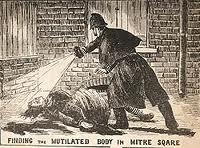
Judging from the popularity of crime series on TV, it seems the modern world is obsessed by murder. However, this gruesome voyeurism is nothing new as revealed in this post about 'murder-tourism' in Regency and Victorian England.
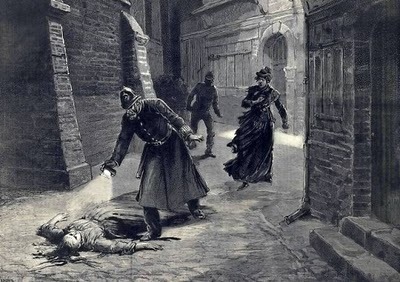
In 1811, a particularly ugly murder whipped up anxiety and fear in the East End of London. One night, Thomas Marr, his wife, baby and a fourteen year old apprentice were bludgeoned to death in their hosiery shop; his servant, Margaret Jewell was only saved because Marr had earlier sent her on an errand and she got lost on the way home.But almost as bad as the murders themselves, were the sight-seers who flocked to see the scene of the crime.
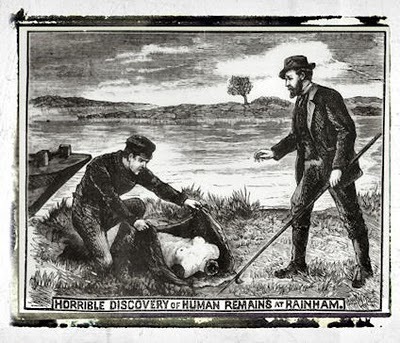
It was usual at the time, to leave bodies in situ for the jury to view, whilst the inquest was held (in a nearby public house or tavern). This had the unfortunate consequence of attracting people to see the crime first hand for themselves:
"…from curiosity to examine the premises," where they entered, "…and saw the dead bodies."
Murder sight-seeing was not uncommon and indeed, some people were not above turning a profit on it.
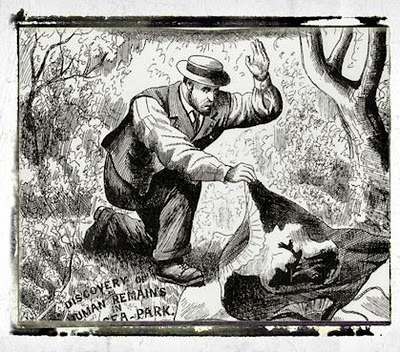
In 1823, William Weare unwisely boasted of his personal wealth and was murdered for his troubles (He was actually penniless.) His body thrown into the pond adjacent to the cottage of a Mr Probert, one of conspirators. The case was widely reported in the press attracting crowds of people on excursions as 'murder tourists'; they wandered through the grounds and payed a shilling to visit the cottage itself. A contemporary publication reported that as many as five hundred people parted with their money and a sightseeing route worked out;
"At Elstree the curious made their first halt, the pond, about a quarter of a mile out of the village…The Artichoke Inn, to which the corpse was carried, and where the Coroner's Inquest was held. Mr Field, the landlord, being one of the Jury, was….fully competent to the task of answering the numerous questions but to him by customers. Here the sack, in which the remains of the Victim had been carried from Probert's cottage, was shown. The marks of blood which it bears gave it peculiar interest…"
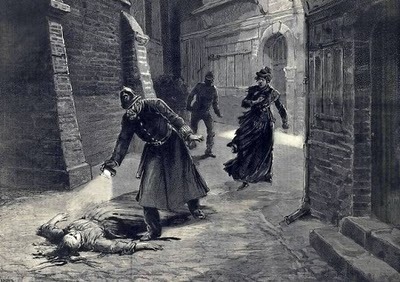
For those wanted, took a souvenir home: be it a bit of the sack the hapless victim was trussed up in, or later, a Staffordshire figure of the murderer. It was even reported that the hedge outside the cottage slowly vanished:
"…filched by those curious people, who consider a twig from the hedge, through which the remains of a murdered man had been dragged, must furnish a treat to their equally curious friends."
It seemed murder-tourists came from all walks of life. Walter Scott, some years later, recorded a visit to this same murder spot: taking in the lanes, pond and cottage itself, where he was shown around by 'a truculent looking hag' for 2s.6d. – the equivalent of a week's pay for a workman. But before we throw up our hands in horror at the terrible goings-on in Victorian times, we'd do well to remember that watching a CSI program on TV, and seeing the murder victim- albeit with a pixellated face, perhaps isn't so far removed from those Victorian murder-tourists!
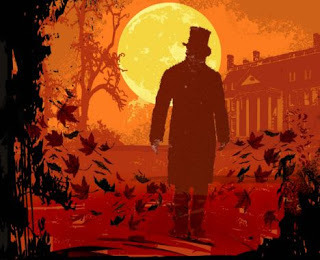
DO YOU WATCH CSI - or other crime related docu-dramas? If so, why? Leave a comment and share your thoughts as to why murder fascinates you.
Grace x
Published on September 25, 2011 09:44
September 18, 2011
Did Anne Boleyn Ride Astride?
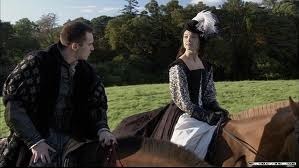 Anne Boleyn (as depicted in The Tudors) riding astride.I'm a huge fan of the TV series 'The Tudors' and have long since accepted the liberties taken historical realism. However, one episode – where Anne Boleyn is shown riding astride – had me reaching for the text books. Surely a lady, like Anne Boleyn, would have ridden side saddle?
Anne Boleyn (as depicted in The Tudors) riding astride.I'm a huge fan of the TV series 'The Tudors' and have long since accepted the liberties taken historical realism. However, one episode – where Anne Boleyn is shown riding astride – had me reaching for the text books. Surely a lady, like Anne Boleyn, would have ridden side saddle?
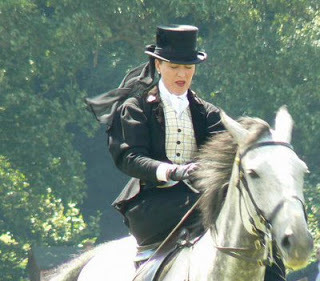 My research revealed illustrations of women riding, literally sitting sideways on a horse, going back to the vases of ancient Greece. Medieval depictions show women seated side-ways, riding pillion behind men, on a small padded seat. Anne of Bohemia 1366 - 1394 created the earliest functional 'side saddle' – a chair life affair with a small footrest, but the rider was still insufficiently secure to control her mount and so had to be led.
My research revealed illustrations of women riding, literally sitting sideways on a horse, going back to the vases of ancient Greece. Medieval depictions show women seated side-ways, riding pillion behind men, on a small padded seat. Anne of Bohemia 1366 - 1394 created the earliest functional 'side saddle' – a chair life affair with a small footrest, but the rider was still insufficiently secure to control her mount and so had to be led.
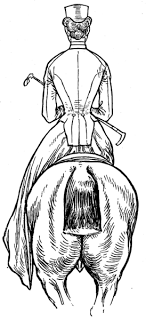 Riding side saddle meant facing forwards instead of sideways, and gave more control.In the 16th century, Catherine de'Medici developed a more practical saddle, complete with a small horn around which the rider hooked her right knee, with the footrest being replaced with a 'slipper stirrup' for the left leg. The meant the rider now sat facing forwards and was therefore able to hold the reins and control her horse, albeit only at sedate paces.
Riding side saddle meant facing forwards instead of sideways, and gave more control.In the 16th century, Catherine de'Medici developed a more practical saddle, complete with a small horn around which the rider hooked her right knee, with the footrest being replaced with a 'slipper stirrup' for the left leg. The meant the rider now sat facing forwards and was therefore able to hold the reins and control her horse, albeit only at sedate paces.
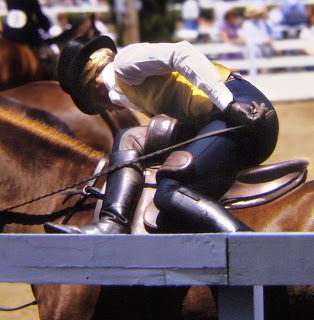 A photo illustrating the secure grip afforded by two horns and a stirrup.
A photo illustrating the secure grip afforded by two horns and a stirrup.Incredibly, it took until the 1830's for a design with a second, lower pommel to trap the left leg and add extra grip, was invented. This extra horn or 'leaping head' was revolutionary in that it allowed women to stay on a horse at a gallop, or even jumping.
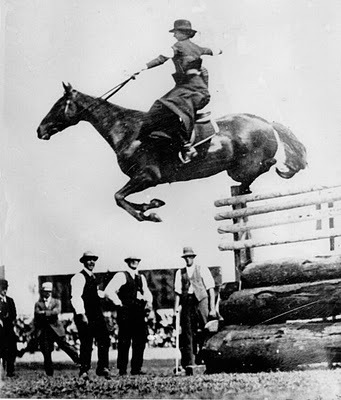 Ester Stace, 1915 - world record the highest jump riding side saddle (6'6")
Ester Stace, 1915 - world record the highest jump riding side saddle (6'6")So as to the question as to how inaccurate is the portrayal of Anne Boleyn riding astride, in The Tudors….The answer goes something like this. As the centuries passed, women of wealth and position desired to control their mounts, but long skirts and social rules meant that it was considered extremely immodest to sit astride (Anne Boleyn take note!) However, and perhaps this is where the producers of The Tudors took their creative license, not all noble women rode side saddle all the time. Women such as Henry II of France's mistress, Diane de Poitiers, Marie Antoinette and Catherine the Great were know to ride astride. So there we have it…who knows, perhaps Anne Boleyn, might…just might…have ridden astride after all.

In series such as, The Tudors, how much does historical inaccuracy bother you?
Published on September 18, 2011 08:36
September 14, 2011
Calls and Calling Cards.
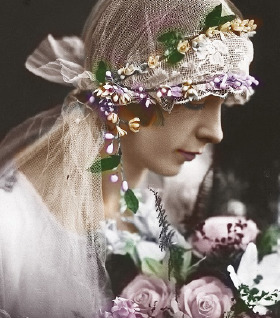
Following on from the previous post 'Advice for the Bride-to-be', one of the social skills a new wife had to master, was the art of paying a call. Although known as 'morning calls', these visits were actually made in the afternoon, at specific times depending on their purpose: ceremonial calls were paid between 3 and 4pm, semi-ceremonial between 4 and 5pm, and intimate calls between 5 – 6pm, - but never on a Sunday which was reserved for very close friends and relatives. Generally a call was limited to 15 minutes, and if other guests arrived during your visit, it was expected you would quietly excuse yourself and leave.
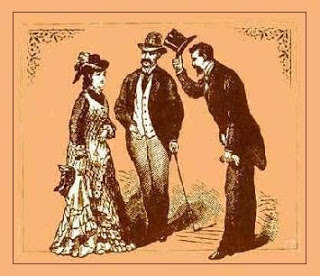
One should never call 'on the off chance' but on pre-set 'at Home' days and times, e.g. the third Friday of each month, or the second Tuesday.
If a wife was new to an area, she might get a lucky break and gain a letter of introduction from a friend to someone of prominence in the local community. These were sometimes referred to as 'letters for soup' because generally the person receiving the letter then invited the bearer to dinner.
A more usual way of announcing yourself into society was to leave your card.
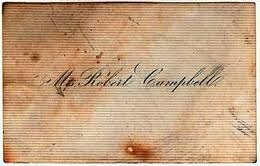
Visiting cards were invented by the French, and adopted in England around 1800. It was imperative to understand the rules of calling, of which card-leaving was the first step. Those wise in the ways of society, left their card but without requesting to see the mistress of the house. Then it was up to the recipient to respond – if no card was sent in return, that was a heavy hint that there was no wish for an acquaintance to develop. The unwise presented their card and then inquired if the mistress was 'at home.' Since you could be physically at-home, but not socially at-home, the visitor had to be prepared for the ignominy of being turned away.
In "Eulogy's Secret'' (due for release November 2011), alone in London, Eulogy Foster calls on her estranged brother for help…but with no card to present, the footman assumes she is a nobody.
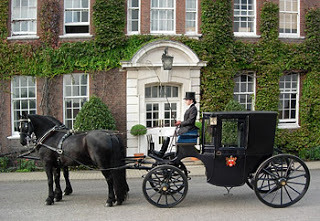 A lady would wait in her carriage whilst a groom presented her card.
A lady would wait in her carriage whilst a groom presented her card. EXCERPT – "Eulogy's Secret" by Grace Elliot.
A surly footman opened the door and squinted into the gloom; sounds of music and raucous laughter spilt over his shoulder."Yes, Miss?""My apologies for the late hour, but I must see Lord Devlin." Eagerly, Eulogy pushed back the hood of her travelling cloak. The footman raised a haughty brow. "His Lordship is not at home.""But His Lordship would wish to see me… I've travelled a long way." Her head buzzed with frustration that this man stood between her and safety.The footman's gaze wandered disapprovingly over her plain wool cloak and battered valise. "Your card, Miss?"Her heart sank. "I don't have one but I'm a close…very close, family friend." She neglected to add that she had yet to meet his Lordship…. "No card? Then what name do I give?" "Miss Foster. Miss Eulogy Foster. Be sure and tell his Lordship that his late mother, Lady Devlin, knew me well.""Wait there, Miss Foster." He withdrew, exuding cool disapproval, leaving her to shiver on the doorstep.
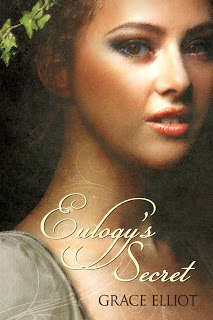
Published on September 14, 2011 12:53
September 11, 2011
Advice for the Bride-to-Be .....Victorian Style!
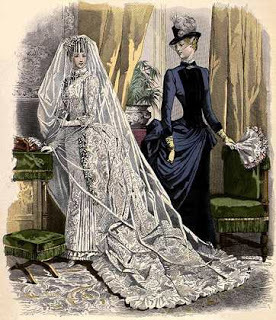
The 1830's and 1840's saw a fashion for manuals devoted to helping women fulfil their roles as both a wife and mother. The aim of these books was to stress the desirability of being the model wife in socially and domestically – advice that the modern reader may find alarmingly comical.
Respectability was everything and the key was knowing the correct etiquette. Published in 1834, 'Hints on Etiquette and the Usages of Society, With a Glance at Bad Habits', defined etiquette as:
"A shield against the intrusion of the impertinent, the improper and the vulgar…."
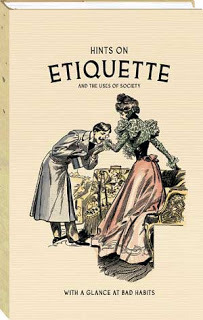
This was the book for any self-respecting bride-to-be to read and memorise….especially if you were from the country, or the offspring of wealthy working people, and therefore hopelessly unfamiliar with proper manners and customs. As the author of 'Hints and Etiquette' wrote:
"Shopkeepers become merchants…with the possession of wealth they acquire a taste for the luxuries of life, expensive furniture, and gorgeous plate; also numberless superfluities, the use of which they are imperfectly acquainted. But although their capacities for enjoyment increase, it rarely occurs that the polish of their manners keeps pace with the rapidity of their advancement. In all cases, the observances of the Metropolis [seat of refinement] should be received as the standard of good breeding."
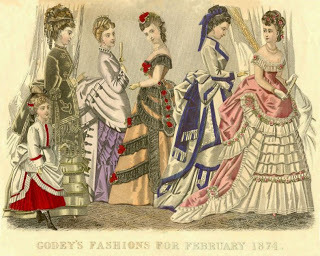 Take care introducing mutual friends....lest they be bores! For the unwary, everything was a mine field – from introducing friends and paying a call, to whom to invite to dinner and table manners – for those not born into society, the task of fitting in must have seemed Herculean.
Take care introducing mutual friends....lest they be bores! For the unwary, everything was a mine field – from introducing friends and paying a call, to whom to invite to dinner and table manners – for those not born into society, the task of fitting in must have seemed Herculean. Even something as simple as introducing friends, was a mine field.
"Never introduce people to each other without a previous understanding that it will be agreeable to both."
The reason runs like this:
"A stupid person may be delighted with the society of a man of learning, to whom in return such an acquaintance may prove annoyance and a clog, as one incapable of offering an interchange of thought, or an idea worth listening to." Harsh!
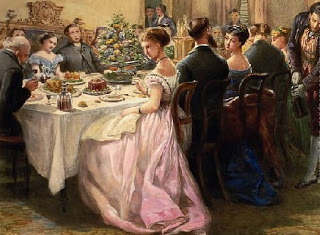
Such was the risk of introducing a bore that if unexpected thrust into the situation of, whilst walking with a friend, bumping into an acquaintance not know to that friend, "Never introduce them." The risk of them proving not to be a kindred spirit was too great! Neither, should you take an uninvited friend, to the home of another, because:
"….there is always a feeling of jealousy that another should share our thoughts and feelings to the same extend as themselves, although good breeding will induce them to behave civilly to your friend on your account."
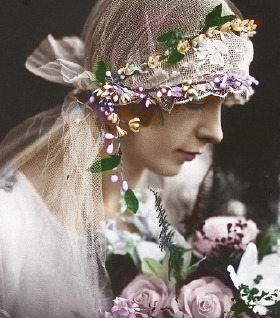
In Wednesday's post – I expound on the ritual of "Calling" – what was proper, and what was improper, as outlined in the 1850 manual, "How to Behave – A Pocket Manual of Etiquette."
Published on September 11, 2011 08:09
September 7, 2011
The Sort of MAN a Woman Likes.
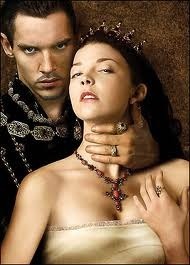 Domineering, Henry VIII - and is unfortunate second wife, Anne Boleyn.Following on from the previous post, the tables turn as women from the early 20th century debate what they like in a man. These comments are taken from articles published in 1913 in the 'Strand Magazine' [famous for publishing Conan Doyle's 'Sherlock Holmes' stories] ; written in response to men espousing that women liked to be dominated, some females give their opinions.
Domineering, Henry VIII - and is unfortunate second wife, Anne Boleyn.Following on from the previous post, the tables turn as women from the early 20th century debate what they like in a man. These comments are taken from articles published in 1913 in the 'Strand Magazine' [famous for publishing Conan Doyle's 'Sherlock Holmes' stories] ; written in response to men espousing that women liked to be dominated, some females give their opinions.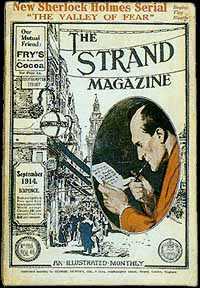
What makes the following comments even more intriguing is that in 1913, the Suffragette movement was in full swing; in June 1913 the suffragette Emily Davison threw herself under the King's horse at Epsom and died three days later. This was a time when women were fighting for the vote, and had ambitions to be treated as equals with men. Fashion tended to polarise into those who donned mannish clothes, as an indication of their political views, and those who donned frills, feathers and furs as a celebration of their womanhood.
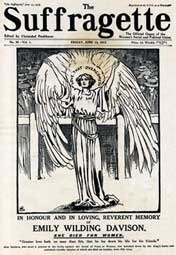 Magazine cover commemorating the death of Emily Davison.Not doubt men were feeling threatened when they suggested women liked to be dominated…and here's what women wrote in response.Adelaide Arnold wrote:
Magazine cover commemorating the death of Emily Davison.Not doubt men were feeling threatened when they suggested women liked to be dominated…and here's what women wrote in response.Adelaide Arnold wrote:"Whilst all women detest a bully, personally, there are many who secretly approve a master."
Marjorie Bowen agreed."I think women do like to be tyrannized over, and the one unforgiveable thing in women's eyes is weakness of the sprit."
Mrs Stanley Wrench seems to back this up:"In her secret heart woman likes to be tryannized over, though never, even to herself will she acknowledge this. If she is in love…there is more of the Cave Woman in her than she imagines."
So much for the suffragist movement!
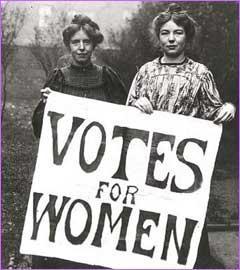
But dissenting voices were beginning to be heard, including Sophie Cole who wrote:"As to being tyrannized over, I think women imagine they like it before marriage, and discover they deterst it after…It is 'understanding' which men and women have craved of each other since the time they were created so dissimilar that the aspiration is impossible of fulfilment."
And the final word goes to the philosophical Mrs H Penrose, who observed:"The average woman has never been very exacting in her demands – perhaps owing to her melancholy preponderance in the marriage market which inclines her to take what she can get and be thankful for the moment."

So please, leave a comment – What do you look for in a man?
Published on September 07, 2011 11:04
August 31, 2011
The Sort of Woman a Man Likes.

The ideal woman? A blend of Angelina Jolie, Charlieze Theron and Carmen Electra!
As an author of historical romance, there's no escaping the different role women had in the past. In the 18th and 19th century, for a woman to amount to anything she had to marry…and to increase the chances of marrying it helped not only to be wealthy…but appealing to men. FOR THE 'I'M A READER NOT A WRITER' BLOG HOP -SEE THE END OF THIS POST$10 AMAZON eVoucher GIVEAWAY FOR ONE LUCKY WINNER.
The sort of woman a man considered an ideal mate, was openly discussed…and enough to make modern toes curl. In 1913, (note: less than a 100 years ago!) The Strand magazine asked some noteable men of the day their views on 'The Sort of Woman a Man Likes.'
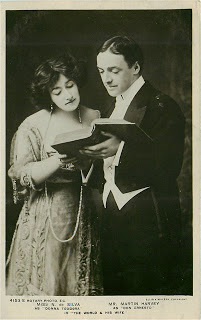
The perfect Edwardian wife - interested in what interests her husband.
F. Frankfort Moore wrote:"She should confine herself to the language of angels if she wishes to be liked by men…Men do not want a polyglot; they want one who will put the kettle on."(NB. Is your blood boiling yet?)
E Temple Thurston added:"…a woman who can minister to his selfishness, without obliterating herself, who can listen to his egotism without making him feel he is monopolizing the conversation."
The novelist Joseph Hocking stated:"He doesn't like a political woman [ie someone with opinions!] …Man's ideal…is a sympathetic companion, who desires to share the joys and sorrows of her husband…a lover of home and children, and finds her greatest joys by the fireside."
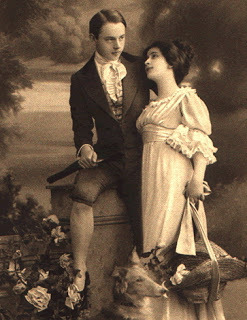
A Victorian couple - wife looking adoringly at her husband.
However, not all men were convinced marriage was a good thing. In 1838, the 29 year old Charles Darwin, was torn between his calling as a scientist and the distraction of taking a wife. In a truly ordered manner, he drew up a list.
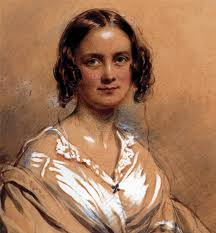
Emma Darwin - the wife, Charles, came to adore.
He listed under "To Marry":- Constant companion who will feel interested in one – better than a dog anyhow.- Someone to take care of the house.- Charms of music and chit-chat – but a terrible loss of time
And under "Not to Marry:"- Freedom to go where I liked – not forced to visit relatives.- Conversation and clever men at clubs- Responsibility and anxiety over children – and less money for books et.c- Perhaps quarrelling – cannot read in the evenings – loss of time – fatness and idleness.So did Darwin marry? Yes, he did…and happily. And at the end of his life he wrote:
"I marvel at my good fortune, that she [Emma, his wife], so ultimately my superior in every single moral quality, consented to be my wife. She has been my adviser and cheerful comforter through life."
FOR MORE MUSINGS ON THE ATTRACTIONS OF THE OPPOSITE SEX:My weekend blog post considers "The Sort of Man a Woman Likes."

The Sort of Man a Woman Likes..?
FOR THE 'I'M A READER NOT A WRITER BLOG HOP' I'M OFFERING A $10 AMAZON eVOUCHER TO ONE LUCKY WINNER.
All you have to do is follow the link and 'Like' my author Facebook page - then leave your email address on the comment section of this blog.
http://www.facebook.com/pages/Grace-Elliot/173092742739684?v=wall&sk=wall
Easy!
Published on August 31, 2011 08:34
August 28, 2011
Welcome! Author Bob Stewart, (aka Thomas A Katt.)
Today, I honoured to have author Bob Stewart, visiting my blog. Bob and I got chatting over a topic of great mutual interest - cats! As it happens, Bob's latest book, "Alias Thomas A Katt" is right up my alley (so to speak) so read on to learn how a story is born!
Grace x
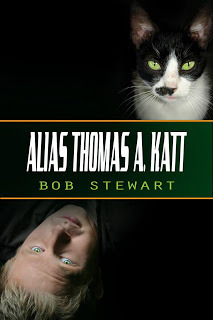
HOW A BOOK IS BORN
We had snakes in the house. Somehow, they found their way into our South Texas home, and we had to get rid of them. What's a natural born snake killer, you ask?
Everyone knows it's a cat.
That's how I found myself at the animal shelter, walking along rows and rows of furry convicts, until I came to one particular character. Black and white, long silky hair, and a hangdog look.
"Okay, Buster," Schyler meowed. "I'll give you one chance." I held my arms out to receive him, opened the cage door, and Schyler pranced out into my wife's arms, and into our hearts. We didn't have a chance.
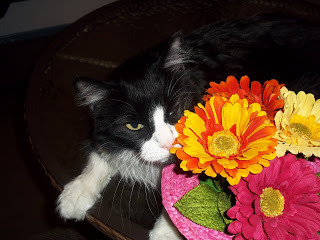
Schyler -
About a hundred dollars later, plus the price of wiggle toy on a string, we brought him home. He took one look around, shrugged as if this new place was better than nothing, and made himself right at home. He didn't have to be taught how to play favorites. My wife's lap became his evening nest where he was stroked and loved.
Me, I became the body servant. It's my job to make sure the water bowl stays full as well as the food dish and the litter box cleaned.
Occasionally he'd walk by my computer, stop, and meow. If I didn't respond immediately by reaching down to pet him, that was it for the day. Sometimes he'd favor me with a long stay by walking a couple feet away flooping onto the carpet, then expecting me to stand on my head to reach him.
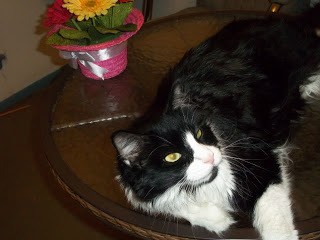
The cat who inspired a book! Schyler.
I came to understand why Schyler was standoffish: Royalty doesn't hob-knob with the common folk – especially the male body servant. I had my place and my function. To everyone else he's a loving kind kitty who beats us to the front door when the doorbell rings, then sits and invites the visitor into the house with happy meows. The whole time they visit, he lies on their feet, a happy, contented, and sweet animal. So it was one night while watching a film noir classic, The Maltese Falcon, with Schyler and Martha that I wondered what would happen if Schyler switched bodies with Humphrey Bogart. Would Schyler develop the "film noir" tough guy persona of a Sam Spade or a Mike Hammer as he masqueraded in human form?
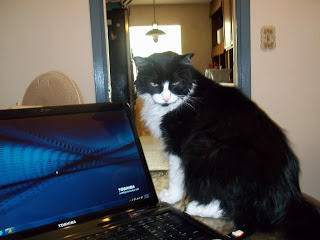
Is it true? Can Schyler type?
Better yet, what if his name was Thomas and he was owned by a lovely librarian named Mallory. Then, one miraculous day at the blessing of the pets he switched bodies with her current boyfriend, a jerk named Tom A. Katt, only to discover that Current Jerk is a killer. Now, he must figure how to be a human, use opposable thumbs – the devil's own invention as far as he's concerned – and protect Mallory in a scenario right out of "feline noir."
In Alias Thomas A, Katt, he's destined to find out just how tough he is as he takes the reader on a first person journey. Oh, and one last thing. We've had no snakes since he came to live with us. Come to think of it, he's pretty good with elephants, too.
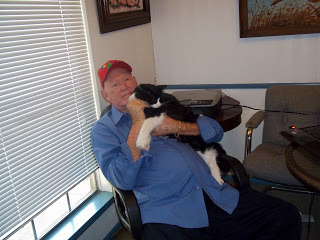
Author, Bob Stewart, and Schyler
Advance review:
Bob Stewart has created his own niche – feline noir –in this kitty caper aptly named Alias Thomas A. Katt. When Tom Katt, a police officer and romantic interest of the lovely Mallory, switches bodies with Mallory's real cat, Thomas, the tables are turned on the bad guys. Even though he's forced to work within the boundaries of an inferior human body, Thomas still has his feline smarts. Bad kitty! takes on new meaning in this fun romp that all cat lovers will find purr-fect.
- Carolyn Haines is the author of Bones of a Feather, the 11th in the Sarah Booth Delaney Delta Mystery series. www.carolynhaines.com

Bob has been kind enough to share an excerpt from "Alias Thomas A Katt."
Chapter One
I hate water, holy or not.
So much that sleep last night was a series of fitful catnaps interrupted by nightmares of a barbaric yearly ritual performed in the name of all that's holy.
Mustering all the pathos I could, I looked up into Mallory's deep-set emerald eyes as we shuffled along the queue for the Blessing of the Pets. The line stretched outside The Mortuary Chapel and across the street into the cemetery.
She stroked my fur, and then gave me a big grin.
"What are you thinking?" She bent over to hug me closer, whispering in my ear. The scent of magnolia blossoms drifted from her hair as I raised my face to be nuzzled. "Sometimes I think you understand more than people realize."
I do understand. I just wished she understood that I did.
"You pay more attention to that damn cat than you do me."
The jerk she calls her current boyfriend has a way of ruining the finest moments. His voice was proof that even in near tropical New Orleans a chill can penetrate the normally temperate October air.
"Don't be silly, Tom. I'm just loving my cat."
"Next thing I know you'll put one of those medals around my neck. Maybe you should, then I'll get to sleep with you, too."
Mallory's hand secretly sought out the Saint Expedite medal on my collar. She bought it for me the first time we came here, put it around my neck, and it never came off. She wears a matching one that drops below the neckline. She used to wear it over her blouse, until she met Current Jerk.
Saint Expedite could teach Current Jerk some manners. I visualized ol' Expedite, standing tall in his niche just inside the front entrance of the church, a young Roman soldier dressed in an historic battle tunic, brown hair tossed in the wind. Instead of the short sword used by grizzled legions to conquer the ancient world for the likes of Julius Caesar, he grasps a cross raised high above his head, ready to cold-cock modern-day heathens right and left.
Like all great historic warriors, Saint Expedite is swift to take action when petitioned. He is even more of a patron saint of lost causes than that wimpy Saint Jude, or that sissy Saint Francis of Assisi, the patron saint of animals, who is about to cause water to be dumped all over my head. These guys run around in dresses, for heaven's sake.
As we neared the entrance, every sinew in my body went taut; I've heard it said that the only things certain in life are death and taxes. I know a third to add to that list.
Only Mallory's sweet touch and Saint Expedite's courage could get me through this, barely, because Expedite's one tough cookie. I'll tell you how tough he is. He's a saint without portfolio because his arrival in New Orleans was sparked by a quirk of tragedy, according to a tour guide I heard on the Travel Channel.
A special chapel was built to speed the funerals through St. Anthony of Padua during the 1826 Yellow Fever epidemic. That piece of grim history earned it the nickname of The Mortuary Chapel. Grieving relatives would scribble the name of a saint on a casket before leaving it at the door of the chapel. The priests would swiftly perform a funeral mass in the name written on it, and shove the contaminated container out the door to a final resting place in the cemetery across the street.
One smelly casket had the word "expedite" scrawled across it. The priests glanced at the word, and chanted a funeral mass to Saint Expedite. When they discovered the error, it was decided to create a Saint Expedite medal in a good-humored effort to acknowledge the mistake. No one took ol' Expedite seriously. After all, he's just the figment of a priest's fertile imagination.
But I always took him seriously. Besides being a good yarn, it just seems to prove the old saying that "people are only human" or "to err is human" or whatever cliché fits best. Of all the saints, he's my favorite, even if he isn't real.
But, Mallory is real. So is her love. I snuggled into her arms in smug satisfaction. In spite of the pending water torture, there's no way life could get any better.
Boy, was I in for a surprise.
About Bob Stewart.
Bob Stewart is the author of four published books, and has reported news events for popular magazines (People, Time, Life, and Latina). He has authored two plays presented by the Aggie Players at Texas A&M University, and two scripts for series television while pursuing a career in journalism. He served as associate producer for Switched at Birth, a television mini-series based on the Kimberly Mays baby switch in Florida. It was nominated for an Emmy.
He has been managing editor of The Bryan Daily Eagle, The Laredo Times, and the Marshall News-Messenger. For ten years, he wrote a daily television column for the San Antonio Light. Next, he pursued a career as a freelance reporter/writer/author. In 1998, he joined the staff of People Magazine as a correspondent, working out of his San Antonio home.
Mexico on spring break.
Man to Man: When the Woman You Love Has Breast Cancer (St. Martin's Press and a Literary Guild Alternate Selection) with co-author Andy Murcia, the husband of entertainer Ann Jillian.
Bob Stewart has worked on a number of national stories for People, including the Oklahoma City bombing, the Branch Davidian standoff in Waco, the murder of Tejano singer Selena, the TWA jet crash in New York, the murder of students at schools in Pearl, Miss., Jonesboro, Ark., and Columbine in Denver, Colo., the racially-motivated murder of James Byrd in Jasper, Tx., the exHis books include:
No Remorse (Pinnacle True Crime and a True Crime Book of the Month club selection) is the true story of Texasserial killer Kenneth McDuff who was convicted of murder, then paroled, when the Supreme Court struck down the death penalty, only to go on a killing spree. McDuff was executed in October, 1998.
Revenge Redeemed (Revell ) is the true story of a Kentuckycouple whose only child was killed by a drunk driver in 1972. They rehabilitated the man who killed their son and today he lives next door to them.
Sacrifice: The Drug Cult Murder of Mark Kilroy (Word Inc.) with co-author Jim Kilroy is the bizarre true story about Mexican drug smugglers who murdered Jim's son, a University of Texaspre-med student as a human sacrifice while the youth was in execution of Karla Faye Tucker, and the kidnap/murder of Mark Kilroy in Matamoras, Mexico.

Grace x

HOW A BOOK IS BORN
We had snakes in the house. Somehow, they found their way into our South Texas home, and we had to get rid of them. What's a natural born snake killer, you ask?
Everyone knows it's a cat.
That's how I found myself at the animal shelter, walking along rows and rows of furry convicts, until I came to one particular character. Black and white, long silky hair, and a hangdog look.
"Okay, Buster," Schyler meowed. "I'll give you one chance." I held my arms out to receive him, opened the cage door, and Schyler pranced out into my wife's arms, and into our hearts. We didn't have a chance.

Schyler -
About a hundred dollars later, plus the price of wiggle toy on a string, we brought him home. He took one look around, shrugged as if this new place was better than nothing, and made himself right at home. He didn't have to be taught how to play favorites. My wife's lap became his evening nest where he was stroked and loved.
Me, I became the body servant. It's my job to make sure the water bowl stays full as well as the food dish and the litter box cleaned.
Occasionally he'd walk by my computer, stop, and meow. If I didn't respond immediately by reaching down to pet him, that was it for the day. Sometimes he'd favor me with a long stay by walking a couple feet away flooping onto the carpet, then expecting me to stand on my head to reach him.

The cat who inspired a book! Schyler.
I came to understand why Schyler was standoffish: Royalty doesn't hob-knob with the common folk – especially the male body servant. I had my place and my function. To everyone else he's a loving kind kitty who beats us to the front door when the doorbell rings, then sits and invites the visitor into the house with happy meows. The whole time they visit, he lies on their feet, a happy, contented, and sweet animal. So it was one night while watching a film noir classic, The Maltese Falcon, with Schyler and Martha that I wondered what would happen if Schyler switched bodies with Humphrey Bogart. Would Schyler develop the "film noir" tough guy persona of a Sam Spade or a Mike Hammer as he masqueraded in human form?

Is it true? Can Schyler type?
Better yet, what if his name was Thomas and he was owned by a lovely librarian named Mallory. Then, one miraculous day at the blessing of the pets he switched bodies with her current boyfriend, a jerk named Tom A. Katt, only to discover that Current Jerk is a killer. Now, he must figure how to be a human, use opposable thumbs – the devil's own invention as far as he's concerned – and protect Mallory in a scenario right out of "feline noir."
In Alias Thomas A, Katt, he's destined to find out just how tough he is as he takes the reader on a first person journey. Oh, and one last thing. We've had no snakes since he came to live with us. Come to think of it, he's pretty good with elephants, too.

Author, Bob Stewart, and Schyler
Advance review:
Bob Stewart has created his own niche – feline noir –in this kitty caper aptly named Alias Thomas A. Katt. When Tom Katt, a police officer and romantic interest of the lovely Mallory, switches bodies with Mallory's real cat, Thomas, the tables are turned on the bad guys. Even though he's forced to work within the boundaries of an inferior human body, Thomas still has his feline smarts. Bad kitty! takes on new meaning in this fun romp that all cat lovers will find purr-fect.
- Carolyn Haines is the author of Bones of a Feather, the 11th in the Sarah Booth Delaney Delta Mystery series. www.carolynhaines.com

Bob has been kind enough to share an excerpt from "Alias Thomas A Katt."
Chapter One
I hate water, holy or not.
So much that sleep last night was a series of fitful catnaps interrupted by nightmares of a barbaric yearly ritual performed in the name of all that's holy.
Mustering all the pathos I could, I looked up into Mallory's deep-set emerald eyes as we shuffled along the queue for the Blessing of the Pets. The line stretched outside The Mortuary Chapel and across the street into the cemetery.
She stroked my fur, and then gave me a big grin.
"What are you thinking?" She bent over to hug me closer, whispering in my ear. The scent of magnolia blossoms drifted from her hair as I raised my face to be nuzzled. "Sometimes I think you understand more than people realize."
I do understand. I just wished she understood that I did.
"You pay more attention to that damn cat than you do me."
The jerk she calls her current boyfriend has a way of ruining the finest moments. His voice was proof that even in near tropical New Orleans a chill can penetrate the normally temperate October air.
"Don't be silly, Tom. I'm just loving my cat."
"Next thing I know you'll put one of those medals around my neck. Maybe you should, then I'll get to sleep with you, too."
Mallory's hand secretly sought out the Saint Expedite medal on my collar. She bought it for me the first time we came here, put it around my neck, and it never came off. She wears a matching one that drops below the neckline. She used to wear it over her blouse, until she met Current Jerk.
Saint Expedite could teach Current Jerk some manners. I visualized ol' Expedite, standing tall in his niche just inside the front entrance of the church, a young Roman soldier dressed in an historic battle tunic, brown hair tossed in the wind. Instead of the short sword used by grizzled legions to conquer the ancient world for the likes of Julius Caesar, he grasps a cross raised high above his head, ready to cold-cock modern-day heathens right and left.
Like all great historic warriors, Saint Expedite is swift to take action when petitioned. He is even more of a patron saint of lost causes than that wimpy Saint Jude, or that sissy Saint Francis of Assisi, the patron saint of animals, who is about to cause water to be dumped all over my head. These guys run around in dresses, for heaven's sake.
As we neared the entrance, every sinew in my body went taut; I've heard it said that the only things certain in life are death and taxes. I know a third to add to that list.
Only Mallory's sweet touch and Saint Expedite's courage could get me through this, barely, because Expedite's one tough cookie. I'll tell you how tough he is. He's a saint without portfolio because his arrival in New Orleans was sparked by a quirk of tragedy, according to a tour guide I heard on the Travel Channel.
A special chapel was built to speed the funerals through St. Anthony of Padua during the 1826 Yellow Fever epidemic. That piece of grim history earned it the nickname of The Mortuary Chapel. Grieving relatives would scribble the name of a saint on a casket before leaving it at the door of the chapel. The priests would swiftly perform a funeral mass in the name written on it, and shove the contaminated container out the door to a final resting place in the cemetery across the street.
One smelly casket had the word "expedite" scrawled across it. The priests glanced at the word, and chanted a funeral mass to Saint Expedite. When they discovered the error, it was decided to create a Saint Expedite medal in a good-humored effort to acknowledge the mistake. No one took ol' Expedite seriously. After all, he's just the figment of a priest's fertile imagination.
But I always took him seriously. Besides being a good yarn, it just seems to prove the old saying that "people are only human" or "to err is human" or whatever cliché fits best. Of all the saints, he's my favorite, even if he isn't real.
But, Mallory is real. So is her love. I snuggled into her arms in smug satisfaction. In spite of the pending water torture, there's no way life could get any better.
Boy, was I in for a surprise.
About Bob Stewart.
Bob Stewart is the author of four published books, and has reported news events for popular magazines (People, Time, Life, and Latina). He has authored two plays presented by the Aggie Players at Texas A&M University, and two scripts for series television while pursuing a career in journalism. He served as associate producer for Switched at Birth, a television mini-series based on the Kimberly Mays baby switch in Florida. It was nominated for an Emmy.
He has been managing editor of The Bryan Daily Eagle, The Laredo Times, and the Marshall News-Messenger. For ten years, he wrote a daily television column for the San Antonio Light. Next, he pursued a career as a freelance reporter/writer/author. In 1998, he joined the staff of People Magazine as a correspondent, working out of his San Antonio home.
Mexico on spring break.
Man to Man: When the Woman You Love Has Breast Cancer (St. Martin's Press and a Literary Guild Alternate Selection) with co-author Andy Murcia, the husband of entertainer Ann Jillian.
Bob Stewart has worked on a number of national stories for People, including the Oklahoma City bombing, the Branch Davidian standoff in Waco, the murder of Tejano singer Selena, the TWA jet crash in New York, the murder of students at schools in Pearl, Miss., Jonesboro, Ark., and Columbine in Denver, Colo., the racially-motivated murder of James Byrd in Jasper, Tx., the exHis books include:
No Remorse (Pinnacle True Crime and a True Crime Book of the Month club selection) is the true story of Texasserial killer Kenneth McDuff who was convicted of murder, then paroled, when the Supreme Court struck down the death penalty, only to go on a killing spree. McDuff was executed in October, 1998.
Revenge Redeemed (Revell ) is the true story of a Kentuckycouple whose only child was killed by a drunk driver in 1972. They rehabilitated the man who killed their son and today he lives next door to them.
Sacrifice: The Drug Cult Murder of Mark Kilroy (Word Inc.) with co-author Jim Kilroy is the bizarre true story about Mexican drug smugglers who murdered Jim's son, a University of Texaspre-med student as a human sacrifice while the youth was in execution of Karla Faye Tucker, and the kidnap/murder of Mark Kilroy in Matamoras, Mexico.
Published on August 28, 2011 09:48
August 24, 2011
Welcome! Author Penny Lockwood Ehrenkranz.
Today, I'm delighted to welcome prolific author, Penny Lockwood Ehrenkrantz, to the blog.
In addition to telling us about herself, Penny is also offering a generous giveaway -to EVERYONE that leaves a comment.
Just leave a comment and contact details and Penny will email you a unique short story "Midsummer Knight" !

Penny Lockwood Ehrenkranz has published hundreds of articles and short stories in print magazines and on-line. She writes for both adults and children. Her fiction has appeared in numerous genre and children's publications and non‑fiction work has appeared in a variety of writing, parenting, and young adult print magazines and on line publications. She edits for three small independent publishers. Visit her web site at http://pennylockwoodehrenkranz.yolasi... Her writing blog is located at http://pennylockwoodehrenkranz.blogspot.com/
GRACE: Penny, lovely to have you here today; please tell the readers a little about what makes you tick.
PENNY: I retired in 2008 from my "day" job as office manager and chief legal secretary of our county district attorney's office. Since then, I have become more of a full-time writer, although I have also taken on some free-lance editing positions. Part of my time is now spent editing other author's work, rather than my own.
I actually enjoy writing in several different genres, including children and young adult. I also write non-fiction and have numerous articles published in writing magazines, parenting magazines and teen magazines. When I'm not writing or editing, I'm reading, crocheting, or gardening. I enjoy water aerobics and walking. My family comes first in my life and I recently became a grandparent for the second time. My son and his wife have a delightful little girl, who is now three, and my daughter and her husband just celebrated the birth of their son in June.
GRACE; I understand you have exciting news that Love Delivery has just been published. Please tell me a little about it. Love Delivery is a novella released by MuseItUp Publishing. Here's a short synopsis: SYNOPSIS LOVE DELIVERY By: Penny Lockwood Ehrenkranz Ann and Tom have both been disappointed in love, yet they yearn for happiness. Ann works as a waitress in a donut shop. Tom has been delivering supplies there for a while. Each is attracted to the other. Tom makes the first move by inviting Ann to dinner and a cat show. Both Tom and Ann have cats, and this brings them together, but there are forces at work tearing them apart even as they seek each other out. Tom's ex-wife, Maria, is hired at the donut shop. Before Ann knows the relationship between Tom and Maria, she confides in Maria about her feelings toward Tom. When Maria learns Ann's beau is her ex-husband, she becomes like a wildcat. She tries everything she can to separate Ann and Tom, including showing up where they're having dinner, going to Ann's apartment, and arriving unannounced at Tom's home when Ann is visiting. To complicate matters, Maria and Tom have a child. Although the Tom is not the biological father, he adores Catherine. As Ann becomes more involved with Tom, she sees both sides of him and wonders if there can be a future. When she gives Tom the ultimatum of getting his life back in order, he disappears. Weeks later, he returns with Catherine, a plan for the future, and a ring for Ann. GRACE: There is a lot of competition for readers' attention these days. What is different about your book that makes people want to read it? PENNY: The story is about two very normal people who don't earn a lot of money and haven't completed their higher educations. They don't work in fancy jobs or live in exciting cities. One is a waitress/day manager of a donut shop and the other a delivery man. But they enjoy life, cats, eating out, movies, children, and bike rides in the country. They are real people with real problems, and I believe readers will be able to relate to the obstacles they have to overcome in their quest for true love.
GRACE: There is a lot of competition for readers' attention these days. What is different about your book that makes people want to read it? PENNY: The story is about two very normal people who don't earn a lot of money and haven't completed their higher educations. They don't work in fancy jobs or live in exciting cities. One is a waitress/day manager of a donut shop and the other a delivery man. But they enjoy life, cats, eating out, movies, children, and bike rides in the country. They are real people with real problems, and I believe readers will be able to relate to the obstacles they have to overcome in their quest for true love.
GRACE: It seems eBooks are taking off in a big way. What is your opinion on eBooks vs. traditional paperbacks?
My next three novelettes from MuseItUp Publishing are eBooks, so I have a very positive opinion of eBooks. My print release from Sam's Dot Publishing (A Past and A Future) is now available through Smashwords, which is a good thing since I've had a number of people ask me how they could get a copy for their eReader.
I think the stigma previously attached to eBooks is no longer valid. I believe this is the wave of the future and eventually very few books will be printed on paper.
I used to enjoy holding a "real" book, but since I acquired a Kindle, I've gotten used to the lightweight of it, the built in reading light, and the fact I can carry a whole library of books with me when I travel. I think eReaders are great. GRACE:What is the kindest act anyone has ever done for you?
When we first moved to Oregon, a very dear friend who recently passed away, took our family under her wing. She wanted my kids to call her "auntie," and she more than deserved the title. Our very first home, she came with paintbrush in hand and helped paint both inside and out. No matter what was needed, she was there. Teri, you'll always be with us.
GRACE: What would your nearest and dearest say is your most annoying habit?
PENNY:That's a tough question to answer since we get along really well. The only thing I can think of might be when we're in the car, and I see something he doesn't see, and I just yell "Dave, Dave, Dave," instead of saying, "There's a kid in the crosswalk," or "There's a car pulling out of that driveway."
GRACE: When was the last time you cried? PENNY: On June 21st when my grandson was born. After telling me for months I couldn't, my daughter relented and allowed me to be in the room and participate in the birth. It was an incredible experience, matched only by being allowed to participate in the birth of my granddaughter three years ago. GRACE:Have you heard of 'Room 101' – the room where an object once placed disappears forever…I wish all alarm clocks went there! What 5 things would you put in Room 101 and why?
PENNY: No, I've never heard of it, but here goes:
1. Alarm clocks (I agree with you on that one)--I hate being forced to wake up.2. Bigotry—I would love to live in a world where diversity was embraced.3. War—It appalls me what people do to each other during a war and I can't seem to fathom the reasons behind war. Live and let live.4. Crime—People should be allowed to live without fear of being beaten, robbed, murdered or abused. 5. Slugs—I hate when they eat my plants after I've worked all summer long trying to grow veggies and flowers.As you can see, I'm a dreamer and would love if conflict were simply eliminated from our society.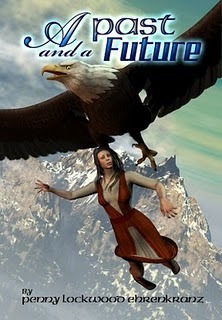 GRACE: It's been lovely chatting with you today, Penny, and before you go, where can I find out more about your books? PENNY: My website and blog: http://pennylockwoodehrenkranz.yolasi... http://pennylockwoodehrenkranz.blogsp... Links for my YA/Adult short story collection: A Past and A Futurehttp://sdpbookstore.com/anthologies.htm http://www.smashwords.com/books/view/... My three releases from MuseItUp Publishing: Love Delivery, coming August, 2011 http://tinyurl.com/4ajo9wz Lady in Waiting, coming November, 2011Mirror, Mirror, coming December, 2011 https://museituppublishing.com/bookstore2 My children's books which will be released through 4RV Publishing: Funny Dog, coming May, 2012 Ghost for Lunch, coming September, 2013 Many Colored Coats, coming October, 2014 Boo's Bad Day, coming June, 2015http://4RVpublishingllc.com/Childrens_Books.htmlGRACE: - Thank you, Penny! If you have enjoyed this interview and would like to sample some of Penny's work, dont forget to leave a comment and contact details, to recieve the short story "Midsummer Knight."
GRACE: It's been lovely chatting with you today, Penny, and before you go, where can I find out more about your books? PENNY: My website and blog: http://pennylockwoodehrenkranz.yolasi... http://pennylockwoodehrenkranz.blogsp... Links for my YA/Adult short story collection: A Past and A Futurehttp://sdpbookstore.com/anthologies.htm http://www.smashwords.com/books/view/... My three releases from MuseItUp Publishing: Love Delivery, coming August, 2011 http://tinyurl.com/4ajo9wz Lady in Waiting, coming November, 2011Mirror, Mirror, coming December, 2011 https://museituppublishing.com/bookstore2 My children's books which will be released through 4RV Publishing: Funny Dog, coming May, 2012 Ghost for Lunch, coming September, 2013 Many Colored Coats, coming October, 2014 Boo's Bad Day, coming June, 2015http://4RVpublishingllc.com/Childrens_Books.htmlGRACE: - Thank you, Penny! If you have enjoyed this interview and would like to sample some of Penny's work, dont forget to leave a comment and contact details, to recieve the short story "Midsummer Knight."

In addition to telling us about herself, Penny is also offering a generous giveaway -to EVERYONE that leaves a comment.
Just leave a comment and contact details and Penny will email you a unique short story "Midsummer Knight" !

Penny Lockwood Ehrenkranz has published hundreds of articles and short stories in print magazines and on-line. She writes for both adults and children. Her fiction has appeared in numerous genre and children's publications and non‑fiction work has appeared in a variety of writing, parenting, and young adult print magazines and on line publications. She edits for three small independent publishers. Visit her web site at http://pennylockwoodehrenkranz.yolasi... Her writing blog is located at http://pennylockwoodehrenkranz.blogspot.com/
GRACE: Penny, lovely to have you here today; please tell the readers a little about what makes you tick.
PENNY: I retired in 2008 from my "day" job as office manager and chief legal secretary of our county district attorney's office. Since then, I have become more of a full-time writer, although I have also taken on some free-lance editing positions. Part of my time is now spent editing other author's work, rather than my own.
I actually enjoy writing in several different genres, including children and young adult. I also write non-fiction and have numerous articles published in writing magazines, parenting magazines and teen magazines. When I'm not writing or editing, I'm reading, crocheting, or gardening. I enjoy water aerobics and walking. My family comes first in my life and I recently became a grandparent for the second time. My son and his wife have a delightful little girl, who is now three, and my daughter and her husband just celebrated the birth of their son in June.
GRACE; I understand you have exciting news that Love Delivery has just been published. Please tell me a little about it. Love Delivery is a novella released by MuseItUp Publishing. Here's a short synopsis: SYNOPSIS LOVE DELIVERY By: Penny Lockwood Ehrenkranz Ann and Tom have both been disappointed in love, yet they yearn for happiness. Ann works as a waitress in a donut shop. Tom has been delivering supplies there for a while. Each is attracted to the other. Tom makes the first move by inviting Ann to dinner and a cat show. Both Tom and Ann have cats, and this brings them together, but there are forces at work tearing them apart even as they seek each other out. Tom's ex-wife, Maria, is hired at the donut shop. Before Ann knows the relationship between Tom and Maria, she confides in Maria about her feelings toward Tom. When Maria learns Ann's beau is her ex-husband, she becomes like a wildcat. She tries everything she can to separate Ann and Tom, including showing up where they're having dinner, going to Ann's apartment, and arriving unannounced at Tom's home when Ann is visiting. To complicate matters, Maria and Tom have a child. Although the Tom is not the biological father, he adores Catherine. As Ann becomes more involved with Tom, she sees both sides of him and wonders if there can be a future. When she gives Tom the ultimatum of getting his life back in order, he disappears. Weeks later, he returns with Catherine, a plan for the future, and a ring for Ann.
 GRACE: There is a lot of competition for readers' attention these days. What is different about your book that makes people want to read it? PENNY: The story is about two very normal people who don't earn a lot of money and haven't completed their higher educations. They don't work in fancy jobs or live in exciting cities. One is a waitress/day manager of a donut shop and the other a delivery man. But they enjoy life, cats, eating out, movies, children, and bike rides in the country. They are real people with real problems, and I believe readers will be able to relate to the obstacles they have to overcome in their quest for true love.
GRACE: There is a lot of competition for readers' attention these days. What is different about your book that makes people want to read it? PENNY: The story is about two very normal people who don't earn a lot of money and haven't completed their higher educations. They don't work in fancy jobs or live in exciting cities. One is a waitress/day manager of a donut shop and the other a delivery man. But they enjoy life, cats, eating out, movies, children, and bike rides in the country. They are real people with real problems, and I believe readers will be able to relate to the obstacles they have to overcome in their quest for true love.GRACE: It seems eBooks are taking off in a big way. What is your opinion on eBooks vs. traditional paperbacks?
My next three novelettes from MuseItUp Publishing are eBooks, so I have a very positive opinion of eBooks. My print release from Sam's Dot Publishing (A Past and A Future) is now available through Smashwords, which is a good thing since I've had a number of people ask me how they could get a copy for their eReader.
I think the stigma previously attached to eBooks is no longer valid. I believe this is the wave of the future and eventually very few books will be printed on paper.
I used to enjoy holding a "real" book, but since I acquired a Kindle, I've gotten used to the lightweight of it, the built in reading light, and the fact I can carry a whole library of books with me when I travel. I think eReaders are great. GRACE:What is the kindest act anyone has ever done for you?
When we first moved to Oregon, a very dear friend who recently passed away, took our family under her wing. She wanted my kids to call her "auntie," and she more than deserved the title. Our very first home, she came with paintbrush in hand and helped paint both inside and out. No matter what was needed, she was there. Teri, you'll always be with us.
GRACE: What would your nearest and dearest say is your most annoying habit?
PENNY:That's a tough question to answer since we get along really well. The only thing I can think of might be when we're in the car, and I see something he doesn't see, and I just yell "Dave, Dave, Dave," instead of saying, "There's a kid in the crosswalk," or "There's a car pulling out of that driveway."
GRACE: When was the last time you cried? PENNY: On June 21st when my grandson was born. After telling me for months I couldn't, my daughter relented and allowed me to be in the room and participate in the birth. It was an incredible experience, matched only by being allowed to participate in the birth of my granddaughter three years ago. GRACE:Have you heard of 'Room 101' – the room where an object once placed disappears forever…I wish all alarm clocks went there! What 5 things would you put in Room 101 and why?
PENNY: No, I've never heard of it, but here goes:
1. Alarm clocks (I agree with you on that one)--I hate being forced to wake up.2. Bigotry—I would love to live in a world where diversity was embraced.3. War—It appalls me what people do to each other during a war and I can't seem to fathom the reasons behind war. Live and let live.4. Crime—People should be allowed to live without fear of being beaten, robbed, murdered or abused. 5. Slugs—I hate when they eat my plants after I've worked all summer long trying to grow veggies and flowers.As you can see, I'm a dreamer and would love if conflict were simply eliminated from our society.
 GRACE: It's been lovely chatting with you today, Penny, and before you go, where can I find out more about your books? PENNY: My website and blog: http://pennylockwoodehrenkranz.yolasi... http://pennylockwoodehrenkranz.blogsp... Links for my YA/Adult short story collection: A Past and A Futurehttp://sdpbookstore.com/anthologies.htm http://www.smashwords.com/books/view/... My three releases from MuseItUp Publishing: Love Delivery, coming August, 2011 http://tinyurl.com/4ajo9wz Lady in Waiting, coming November, 2011Mirror, Mirror, coming December, 2011 https://museituppublishing.com/bookstore2 My children's books which will be released through 4RV Publishing: Funny Dog, coming May, 2012 Ghost for Lunch, coming September, 2013 Many Colored Coats, coming October, 2014 Boo's Bad Day, coming June, 2015http://4RVpublishingllc.com/Childrens_Books.htmlGRACE: - Thank you, Penny! If you have enjoyed this interview and would like to sample some of Penny's work, dont forget to leave a comment and contact details, to recieve the short story "Midsummer Knight."
GRACE: It's been lovely chatting with you today, Penny, and before you go, where can I find out more about your books? PENNY: My website and blog: http://pennylockwoodehrenkranz.yolasi... http://pennylockwoodehrenkranz.blogsp... Links for my YA/Adult short story collection: A Past and A Futurehttp://sdpbookstore.com/anthologies.htm http://www.smashwords.com/books/view/... My three releases from MuseItUp Publishing: Love Delivery, coming August, 2011 http://tinyurl.com/4ajo9wz Lady in Waiting, coming November, 2011Mirror, Mirror, coming December, 2011 https://museituppublishing.com/bookstore2 My children's books which will be released through 4RV Publishing: Funny Dog, coming May, 2012 Ghost for Lunch, coming September, 2013 Many Colored Coats, coming October, 2014 Boo's Bad Day, coming June, 2015http://4RVpublishingllc.com/Childrens_Books.htmlGRACE: - Thank you, Penny! If you have enjoyed this interview and would like to sample some of Penny's work, dont forget to leave a comment and contact details, to recieve the short story "Midsummer Knight."
Published on August 24, 2011 03:05
'Familiar Felines.'
Following on from last weeks Halloween posting, today's blog post looks at the unwanted image of cats as the witches familiar - from the Norse Goddess Freya to lonely women in the middle ages.
The full Following on from last weeks Halloween posting, today's blog post looks at the unwanted image of cats as the witches familiar - from the Norse Goddess Freya to lonely women in the middle ages.
The full post can found at:
http://graceelliot-author.blogspot.com
...more
The full Following on from last weeks Halloween posting, today's blog post looks at the unwanted image of cats as the witches familiar - from the Norse Goddess Freya to lonely women in the middle ages.
The full post can found at:
http://graceelliot-author.blogspot.com
...more
- Grace Elliot's profile
- 156 followers



